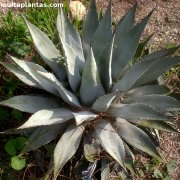Care of the succulent plant Agave parryi or Mescal agave |
|
The Agave genus, a subfamily of the Agavoideae, comprises some 300 species of succulent plants native to Mexico, Central America and the Southwest of the USA. Some species are: Agave parryi, Agave parrasana, Agave macroacantha, Agave filifera, Agave bracteosa, Agave attenuata, Agave americana, Agave stricta, Agave potatorum, Agave victoria-reginae, Agave striata, Agave impressa, Agave deserti, Agave chiapensis, Agave palmeri, Agave vivipiara, Agave ferox, Agave sisalana, Agave ferdinandi-regis, Agave shawii, Agave angustifolia, Agave vilmoriniana, Agave univittata, Agave guadalajarana, Agave lechuguilla, Agave datylio. Common names: Mescal agave, Parry's agave. This species is native to northern Mexico and Arizona. They are rounded succulent plants with rosette leaves that reach a height of more than 4 meters (13 feet) during the flowering season. The leaves have hooked garnet spines on the edge and measure up to 40 cm (1.31 feet) in length; the color is grayish or somewhat bluish. The flowers, yellow or orange, appear in a branched inflorescence that protrudes above the plant and exceeds 4 meters (13 feet) in height. The plant dies after flowering but tends to produce suckers at its base. Mescal agave is used to form groups or in rockery they are grown in pots for patios and terraces. Agave parryi needs exposure to full sun and high temperatures; They tolerate frosts of up to -5 ºC (23 ºF) if the soil is dry. The soil needs to be very well drained, for which a mixture of one third of garden substrate, one third of coarse sand and another third of leaf mulch can be used. Potting is done in the spring. Water moderately in summer, always waiting for the soil to be dry. The rest of the year they should not be watered if they are grown outdoors; if they are in a pot they will be watered a little more. Parry's agave does not need special fertilizations or pruning. Agave parryi is resistant to pests and diseases; it is only necessary to watch the excess of water and the mealybugs in the young specimens. The most common form of propagation is from the shoots that the plant produces at its base. |
Images of the succulent plant Agave parryi or Mescal agave |
Find plants
Agave parryi or Mescal agave | Care and Growing
© 2025 FavThemes


